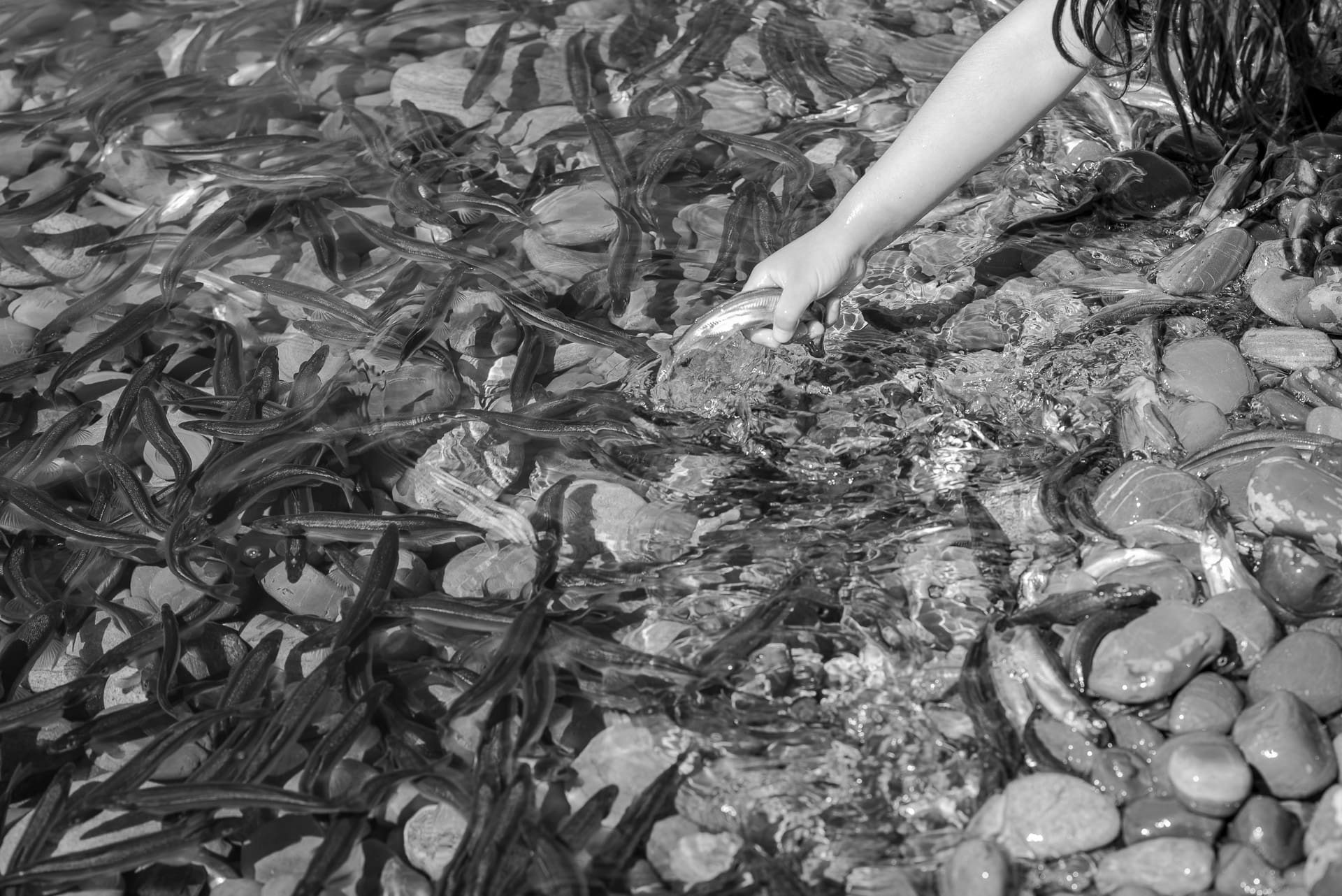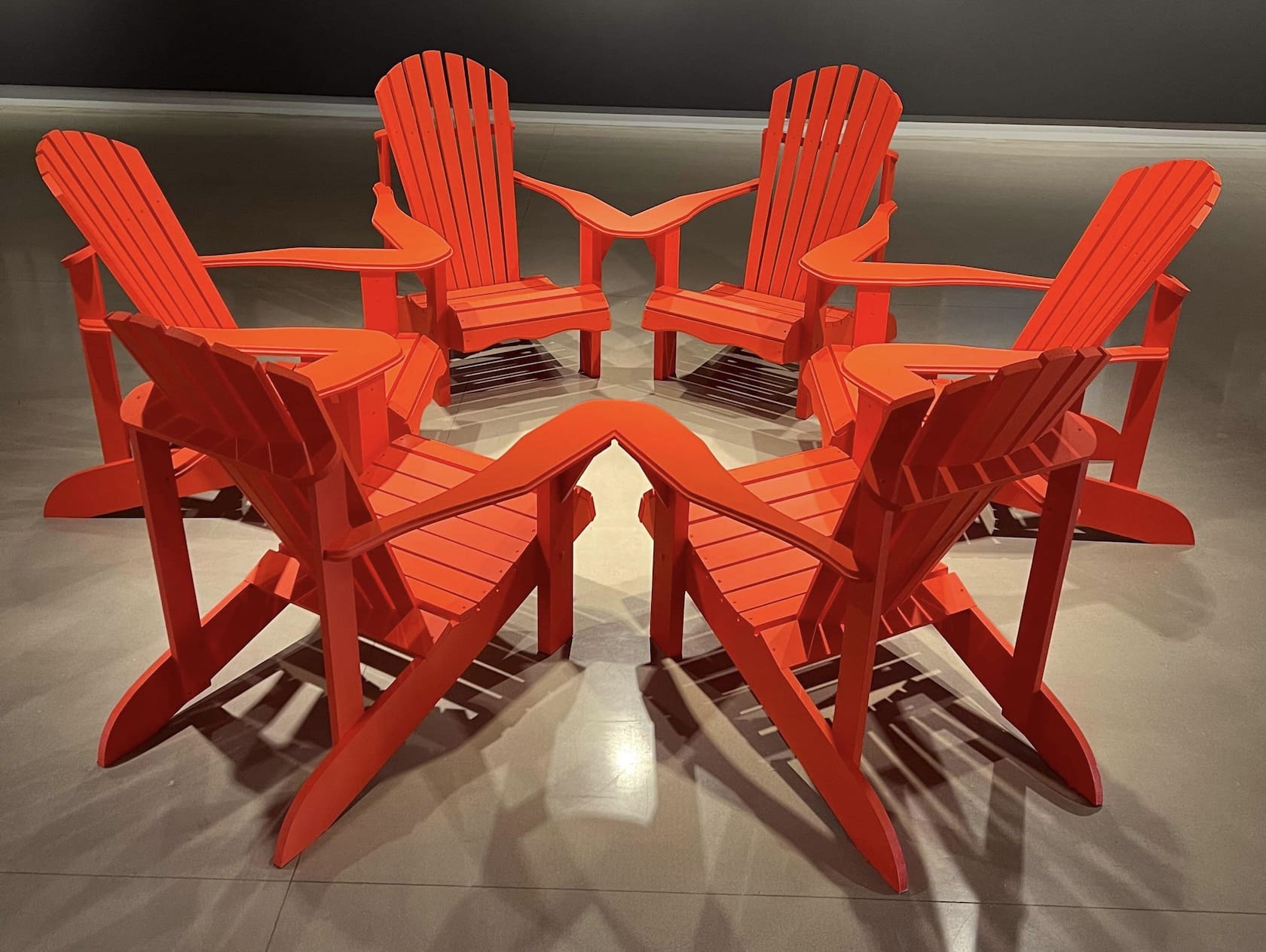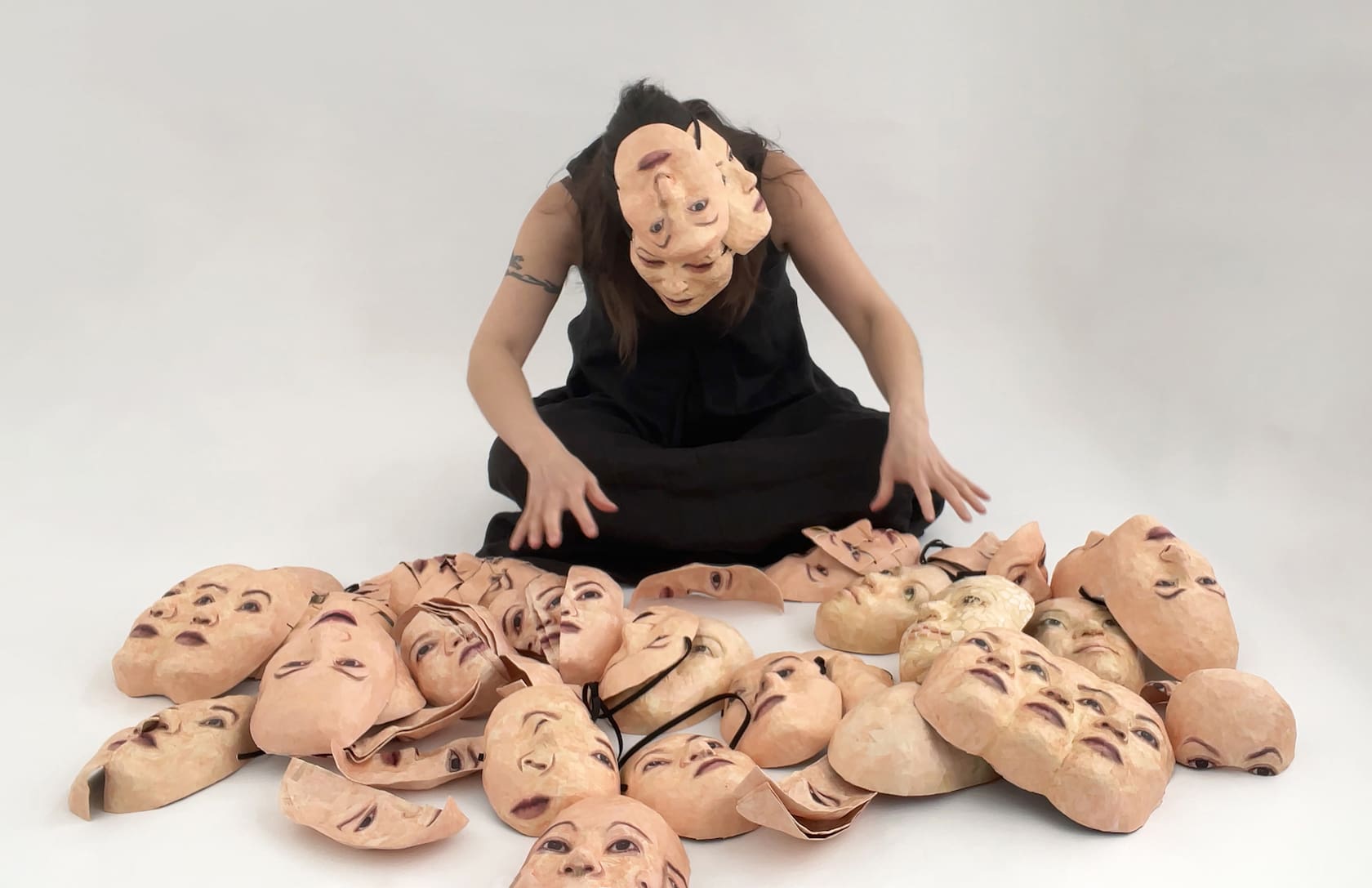On Hosting
by Bushra Junaid
Letitia Fraser, Civil Boom, 2021, acrylic on quilt, 30 x 30”
On Hosting
By Bushra Junaid
Summertime, a few years ago. A friend and I are headed to Fogo Island. We take the northeastern highway, stopping at beaches along the way. We find a bed-and-breakfast for the night. The owner is not there to receive us but has left instructions to access the house. Windswept and weary, we slumber beneath handmade bedspreads.
In the morning, as we help ourselves to a generous breakfast, our host enters the dining room and bounds toward us. Her bright, wide eyes are fixated on me with pleasant curiosity. Her hand outstretched, she smiles broadly and enunciates each word: “Welcome! Where–are–you–from?”
Having been asked the same question several times already on this trip (and throughout my upbringing in Newfoundland and Labrador), I know the score. Looking at me, our B & B host expects me to be from an exotic, faraway land. Anywhere but “St. John’s,” which I deliver with an exaggerated east-end brogue.
Our host’s brow furrows; her mouth gapes and cheeks flush. She looks confused and disappointed. I am not who comes to mind when she considers who a fellow Newfoundlander is. I’m not the desired “come from away” she had prepared for. Embarrassed, she shrugs slightly, turns, and wanders off.

Ethel Brown. Capelin Days, 2020. black-and-white photograph, 8 in. x 12 in.
I think of the posture we take when welcoming others. How we perceive and receive them. What we expect of and from them. The assumptions we make.
The gracious host tries to make their guest feel at home, but implicit in the exchange is that one is the giver and the other the receiver or taker. They are on unequal footing. The guest may overstay their welcome, not conform to the host’s expectations, or be asked to leave for any reason.
The guest says: I feel welcomed by you – or, conversely, I feel alienated from, rejected, or merely tolerated by you.

Don Kwan, This Land is My Land, This Land is Your Land, 2022. Installation view, Ottawa Art Gallery. Courtesy of the artist.
I am the child of African and Caribbean immigrants. My father was from the Yoruba people of Nigeria and my mother is from Jamaica.
My mother immigrated to Montreal in the late 1950s, sponsored under the West Indian Domestic Scheme (1955–1967), which brought Caribbean women to work for Canadian households. My father immigrated to Quebec to study at Laval University.
My parents met, married, and had four daughters in Montreal, me included. They moved to St. John’s in the late 1960s for my father to take up a teaching position at Memorial University. My younger brother was born in the city.
Growing up in St. John’s was a unique experience. At home we were enveloped by our mother’s faith, warmth, Caribbean way of being, colourful expressions, laughter, singing, Jamaican folktales, and wonderful cuisine. My mother would take a classic Newfoundland dish like pan-fried capelin and make it her own by cooking it with onion, hot pepper, herbs, and vinegar to make escovitch fish. On the rare occasions when she got her hands on a cherished can of ackee fruit, she would prepare Jamaica’s national dish, ackee and saltfish.
At school and out in the world, we experienced Newfoundland’s food, culture, brilliant sense of humour and use of language, and rich folk traditions.
I am grateful for the influence of both these strong island cultures: Jamaica and Newfoundland.
However, my siblings and I grew up in the 1970s without extended family nearby. There was little representation of Black people in the media or popular culture and no Black teachers, role models or mentors, outside my immediate household. I was always the only Black child in my class.
I wasn’t taught in school how my family’s African-Caribbean history intersected with Newfoundland and Labrador’s.
My siblings and I were taunted for the colour of our skin and constantly told to go back to where we come from.
Schoolmates made fun of us for our strange names. Unwitting teachers stood my sister and me in front of the school when collecting for UNICEF as examples of impoverished children from Africa.
Family friends wondered aloud about who we’d date when we got older, as they couldn’t possibly imagine us partnering with their children.
There were persistent incidents, macro and micro, that reminded us that we didn’t fully belong.
These experiences have left me preoccupied with questions of identity and belonging. What does it mean when your childhood memories, stories, and attachments or those of your parents are tied to other cultures, languages, histories, geographies, and landscapes? What does it mean to be told to go back to where you belong when you don’t know where that is? Where do you belong?
I also wonder what it feels like to have a deep-rooted multigenerational sense of connection to the history, traditions, and culture of a place, as so many Newfoundlanders do?
Ethel Brown’s black-and-white photographs of family life and home, nature, and the surrounding landscape show the everydayness of life and shared connections between people and the natural environment. They bond her and her children to a place where they are both at home and perceived by others as perpetual newcomers. These images of life, love, and beauty are acts of resistance or insistence. She is inscribing herself and her family onto this place, ensuring their legacy and asserting their right to be.
Miya Turnbull’s ongoing exploration of mask-making speaks to what we show of ourselves, what we choose to keep hidden, and where we situate the liminal space of mixed cultural identity. Her work has us reflect on the parts of ourselves we suppress in order to belong or conform to society and institutions. For me it asks whether and when we are allowed to show up as our whole selves.
Letitia Fraser’s painted story quilts honour her community of North Preston, Nova Scotia. They show her respect, care, and love for the people she portrays. Her work conveys the self-sacrificing ways in which Black women nurture and allow others to thrive while rarely receiving recognition, reciprocity, or rest. These women draw on ancestral and Indigenous ways of knowing and being to wrest healthy, rich soil from rocky, inhospitable terrain and produce gardens that flourish.
Don Kwan’s sculpture, installation, photography, and performance works reflect on identity, belonging, outsider status, marginalization, privilege, and intergenerational memory, drawing on his lived experience as a third-generation, queer, East Asian male.
I’m interested in how art can give voice to alienation, loss, and rootlessness, repair the ruptures of colonization and displacement, play a role in healing and integration, and forge a sense of connection and well-being. How do we use it to welcome others and create a caring community?
The theme of the 2023 Bonavista Biennale is “host,” as explored through the perspectives of artists from diverse backgrounds, disciplines, and artistic practices. Some of these artists explore the interdependency of humans and more-than-human beings, the life-sustaining force of the land and waters, and the risk to ecosystems of human actions.
Other artists in the Biennale speak to the impacts of colonization on and the importance of asserting Indigenous sovereignty, stewardship of land and environments, knowledge, storytelling, and ways of being, and the need to come together in mutually beneficial and reciprocal ways as Indigenous peoples, settlers, and newcomers.
Some of these artists seek to honour ancestral memory and intergenerational exchange, community connections, love of culture and family.
And in particular, some artists of colour use their work to reflect on questions of identity and representation, erasure, inclusion and exclusion, and marginalization: questions that resonate closely for me.

Miya Turnbull, Self-Portrait (Multiple Selves), 2022. Digital Photograph (Film Still), 16″ x 20”
In my own artistic and curatorial work, I have begun to weave Black history and presence into the narrative of Newfoundland and Labrador. As I have examined archival materials, I have learned how African-descended people have been part of the story of this place from the beginning. I am tracing our role in seafaring and other endeavours, and the part played by Newfoundland and Labrador in the centuries-long Triangle Trade in enslaved people and commodities.
African-descended people in Newfoundland are not, as we are often thought to be, recent arrivals and guests. Recognizing that my people have far deeper roots in Newfoundland and Labrador than anyone realized, I am no longer a guest in my home province, but rather a host. I bring a new understanding of hidden and untold histories that reveal how Black history and presence is an inextricable part of the province’s better-known history.
My work has been a source of conversation, connection, and creation. It has given me a feeling of belonging and brought new perspectives on belonging, upending things for myself and others.
When I ask my mother about her cultural traditions around hosting, she tells me about growing up in her Jamaican village. Like Newfoundland, Jamaica is surrounded by the sea. “People didn’t live an opulent life but if somebody was in need, even if you had to sleep on the floor, you would invite them in.” Her grandparents would put two chairs together and lay a sheet of wood on top to fashion a bed for guests.
To my mother, the host-guest relationship requires reciprocity to thrive. “When you sow a seed, you expect it to grow. If you don’t nourish it by watering it, it will either go wild or die. Host and recipient must nourish one another.”
What my mother says about hosting or caring for others is exemplified by her life. After moving to Newfoundland and Labrador in the late 1960s, she looked after elderly people and those who were sick and infirm, comforting them and supporting their families. She did so quietly and without drawing attention to herself.
As an immigrant mother of five – including a newborn – she took in a stranger, an elderly Newfoundlander abandoned by his family, and cared for him in our home for the last couple of months of his life. He died with his arms around her, words of blessing and gratitude on his lips.
For years my mother visited another stranger weekly, a Caribbean woman placed in a nursing home after a car accident left her in a coma. My mother talked to her and read and sang to her. We have many such stories of my mother’s generosity, deep sense of empathy, and compassion toward others.
Food was another way in which she showed love and care. There was always a pot of soup ready for the unexpected guest, or she was quick to prepare one to drop off to someone ailing, no matter how inclement the weather.
Although many Newfoundlanders regarded us as guests, my mother’s kindness and nurturing of individuals and families of multigenerational and immigrant backgrounds demonstrated that how we welcome and receive others matters. Done right, it can cultivate feelings of acceptance, belonging, inclusion, and reciprocity; it can aid in the development of healthy, mutually beneficial relationships. It can turn a guest into a host.
Bushra Junaid is a multidisciplinary artist-curator based in Toronto whose work probes themes of history, memory, identity and placemaking. She is a member of the 2023 Bonavista Biennale’s Curatorial Advisory. Junaid’s project What Carries Us: Newfoundland and Labrador in the Black Atlantic at The Rooms Provincial Art Gallery (2020) included video, mixed media, mural and photo-based works by Canadian and international artists as well as rare archival items, pivoting on Paul Gilroy’s concept of the “Black Atlantic” while also reflecting on John Akomfrah’s Vertigo Sea (2015). In 2016, Junaid co-curated (with Pamela Edmonds) New-Found-Lands: An Art Project Exploring Historical and Contemporary Connections between Newfoundland and the Caribbean Diaspora at Eastern Edge Gallery.
